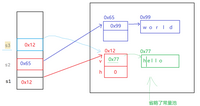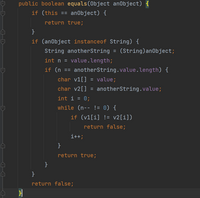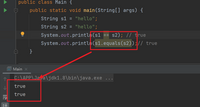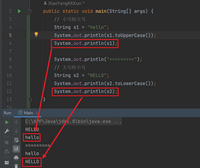
?博客主页:爱敲代码的小杨.
✨专栏:《Java SE语法》
❤️感谢大家点赞??收藏⭐评论✍?,您的三连就是我持续更新的动力❤️
文章目录
前言1. String类1.1 字符串的构造1.2 String对象的比较1. ==比较是否引用同一个对象2. equals()方法:按照字典序比较3. compareTo()方法: 按照字典序进行比较4. 忽略大小写比较 1.3 字符串查找1.4 转换1. 数值和字符串转化2. 大小写转化3. 字符串转数组4. 格式化 1.5 字符串替换1.6 字符串拆分1.7 字符串的截取1.8 其他操作 2. StringBuilde 类 和 StringBuffer类
前言
在程序开发中经常会用到字符串。字符串是指一连串的字符,它是由许多单个字符连接而成的,如多个英文字母所组成的英文单词。字符串可以包含任意字符,这些字符必须包含在一对双引号""之内,例如:“abc”。Java定义了3个封装字符串的类,分别是String类、StringBuffer类和StringBulider类。它们位于java.lang 包中,并提供了一系列操作字符串的方法,这些方法不需要导包就可以直接使用。下面将对String类、StringBuffer类和StringBulider类进行讲解。
1. String类
1.1 字符串的构造
String类提供了构造方法非常多,常用的就以下三种:
public class Main { public static void main(String[] args) { // 使用常量串构造 String s1 = "hello"; System.out.println(s1); // 直接new String对象 String s2 = new String("hello"); System.out.println(s2); // 使用字符数组进行构造 char[] chars = {'h','e','l','l','o'}; String s3 = new String(chars); System.out.println(s3); }}其他方法需要用到时,大家参考Java在线文档:String官方文档
【注意】:
String是引用类型,内部并不存储字符串本身,在String类的实现源码中,String类实例变量如下: 
public class Main { public static void main(String[] args) { // s1和s2引用的是不同对象 s1和s3引用的是同一对象 String s1 = new String("hello"); String s2 = new String("world"); String s3 = s1; // s3这个引用指向了s1这个引用的对象 System.out.println(s3); // hello System.out.println(s1.length());// 获取字符串的长度 System.out.println(s1.isEmpty());// 如果字符串长度为0,返回true,否则返回false String s4 = ""; System.out.println(s4.length()); // 0 System.out.println(s4.isEmpty());// true}内存图:


在Java中""引起来的也是String类型对象
// 打印"hello"字符串(String对象)的长度System.out.println("hello".length());// 51.2 String对象的比较
字符串的比较是常见操作之一,比如:字符串排序。Java中总共提供了4种方式:
1. ==比较是否引用同一个对象
注意:对于内置类型,==比较的是变量中的值;对于引用类型==比较的是引用中的地址。
public class Main { public static void main(String[] args) { int a = 10; int b = 20; int c = 10; // 对于基本类型变量,==比较两个变量中存储的值是否相同 System.out.println(a == b); // false System.out.println(a == c); // true // 对于引用类型变量,==比较两个引用变量引用的是否为同一个对象 String s1 = new String("hello"); String s2 = new String("hello"); String s3 = new String("world"); String s4 = s1; System.out.println(s1 == s2); // false System.out.println(s2 == s3); // false System.out.println(s1 == s4); // true }}2. equals()方法:按照字典序比较
字典序:字符大小的顺序
String类重写了父类Object中equals方法,Object中equals默认按照==比较,String重写equals方法后,按照 如下规则进行比较,比如:s1.equals(s2)

public class Main { public static void main(String[] args) { String s1 = new String("hello"); String s2 = new String("hello"); String s3 = new String("Hello"); // s1、s2、s3引用的是三个不同对象,因此==比较结果全部为false System.out.println(s1 == s2); // false System.out.println(s1 == s3); // false // equals比较:String对象中的逐个字符 // 虽然s1与s2引用的不是同一个对象,但是两个对象中放置的内容相同,因此输出true // s1与s3引用的不是同一个对象,而且两个对象中内容也不同,因此输出false System.out.println(s1.equals(s2)); // true System.out.println(s1.equals(s3)); // false }}【注意】:为什么以下代码输出的结果都是true?

答:因为在 Java 中有一块特殊的内存(常量池),存储在堆上。
它的作用是什么呢?
只要是""双引号括起来的字符串存放在这里。存储字符串之前它会找常量池里是否存在这个字符串,如果有就不存放了(常量池不会重复存放相同的值),所以上述代码中s1和s2都指向常量池hello的地址。 
3. compareTo()方法: 按照字典序进行比较
与equals不同的是,equals返回的是boolean类型,而compareTo返回的是int类型。具体比较方式:
public class Main { public static void main(String[] args) { String s1 = new String("abc"); String s2 = new String("ac"); String s3 = new String("abc"); String s4 = new String("abcdef"); // s1 和 s2 比较大小 s1 > s2 返回大于0的数字 s1 < s2 返回小于0的数字 否则返回0 // 返回差值就是对应acsii码的差值 System.out.println(s1.compareTo(s2)); // 不同输出字符差值-1 System.out.println(s1.compareTo(s3)); // 相同输出 0 System.out.println(s1.compareTo(s4)); // 前k个字符完全相同,输出长度差值 -3 }}4. 忽略大小写比较
equalsIgnoreCase()方法:与equals()方式相同,但是忽略大小写比较。
compareToIgnoreCase()方法:与compareTo()方式相同,但是忽略大小写比较。
public class Main { public static void main(String[] args) { String s1 = new String("abc"); String s2 = new String("Abc"); System.out.println(s1.equals(s2)); // false System.out.println(s1.equalsIgnoreCase(s2)); // true System.out.println(s1.compareTo(s2));//32 System.out.println(s1.compareToIgnoreCase(s2));// 0 }}1.3 字符串查找
字符串查找也是字符串中非常常见的操作,String类提供的常用查找的方法
| 方法 | 功能 |
|---|---|
| char charAt(int index) | 返回index位置上字符,如果index为负数或者越界,抛出 IndexOutOfBoundsException异常 |
| int indexOf(int ch) | 返回ch第一次出现的位置,没有返回-1 |
| int indexOf(int ch, int fromIndex) | 从fromIndex位置开始找ch第一次出现的位置,没有返回-1 |
| int indexOf(String str) | 返回str第一次出现的位置,没有返回-1 |
| int indexOf(String str, int fromIndex) | 从fromIndex位置开始找str第一次出现的位置,没有返回-1 |
| int lastIndexOf(int ch) | 从后往前找,返回ch第一次出现的位置,没有返回-1 |
| int lastIndexOf(int ch, int fromIndex) | 从fromIndex位置开始找,从后往前找ch第一次出现的位置,没有返 回-1 |
| int lastIndexOf(String str) | 从后往前找,返回str第一次出现的位置,没有返回-1 |
| int lastIndexOf(String str, int fromIndex) | 从fromIndex位置开始找,从后往前找str第一次出现的位置,没有返 回-1 |
public class Main { public static void main(String[] args) { String s1 = new String("hello"); // 返回字符串对应下标的字符 System.out.println(s1.charAt(1)); // e //返回对应字符出来的下标位置 从头开始查找 System.out.println(s1.indexOf('e')); // 1 //返回对应字符出来的下标位置 从指定位置查找 System.out.println(s1.indexOf('l', 3)); // 3 // 字符串查找 从一个字符串找另一个字符串 System.out.println(s1.indexOf("llo")); // 2 System.out.println(s1.indexOf("ll", 2));// 2 // 返回对应字符出来的下标位置 从尾开始向前查找 System.out.println(s1.lastIndexOf('l'));// 3 // 返回对应字符出来的下标位置 从指定位置向前查找 System.out.println(s1.lastIndexOf('l', 1));// -1 System.out.println(s1.lastIndexOf("ll")); // 2 System.out.println(s1.indexOf("ll", 1));// 2 }}1.4 转换
1. 数值和字符串转化
public class Main { public static void main(String[] args) { // 数字转字符串 String s1 = String.valueOf(123); System.out.println(s1); String s2 = String.valueOf(12.34); System.out.println(s2); String s3 = String.valueOf(true); System.out.println(s3); // 字符串转数字 int num1 = Integer.parseInt("1234"); System.out.println(num1); double num2 = Double.parseDouble("12.34"); System.out.println(num2); }}2. 大小写转化
public class Main { public static void main(String[] args) { // 小写转大写 String s1 = "hello"; System.out.println(s1.toUpperCase()); // 大写转小写 String s2 = "HELLO"; System.out.println(s2.toLowerCase()); }}问题:转化为大写/小写是在原来的字符串上进行修改的?
答:不是!!!,转化为大写/小写之后,是产生了一个新的对象
通过String类源码中的toUpperCase()方法和toLowerCase()方法返回的都是一个新的字符串。

验证:

3. 字符串转数组
public class Main { public static void main(String[] args) { // 字符串转数组 String s1 = "hello"; char[] chars = s1.toCharArray(); for (char ch : chars) { System.out.println(ch); } // 数组为字符串 String s2 = new String(chars); System.out.println(s2); }}4. 格式化
public class Main { public static void main(String[] args) { String s1 = String.format("%d-%d-%d",2021,5,19); System.out.println(s1); }}1.5 字符串替换
使用一个指定的新的字符串替换掉已有的字符串数据,可用的方法如下:
| 方法 | 说明 |
|---|---|
| String replaceAll(String regex, String replacement) | 替换所有的指定内容 |
| String replaceFirst(String regex, String replacement) | 替换收个内容 |
public class Main { public static void main(String[] args) { String s1 = "abcabcdeabcd"; System.out.println(s1.replace('a', 'p')); // pbcpbcdepbcd System.out.println(s1.replace("ab","haha")); // hahachahacdehahacd System.out.println(s1.replaceAll("ab", "uuu")); // uuucuuucdeuuucd System.out.println(s1.replaceFirst("ab", "ha")); // hacabcdeabcd }}1.6 字符串拆分
可以将一个完整的字符串按照指定的分隔符划分为若干个子字符串。
| 方法 | 功能 |
|---|---|
| String[] split(String regex) | 将字符串全部拆分 |
| String[] split(String regex, int limit) | 将字符串以指定的格式,拆分为limit组 |
public class Main { public static void main(String[] args) { String s1 = "name = zhangsan&age = 18"; String[] strings = s1.split("&"); for (int i = 0; i < strings.length; i++) { System.out.println(strings[i]); } String s2 = "Hello handsome hello beautiful give me some attention"; // 帅哥美女点点关注 String[] strings1 = s2.split(" ",12); // 虽然不能分割12次 但是它能够保证能分割的最大次数 不够就不分了 for (int i = 0; i < strings1.length; i++) { System.out.println(strings1[i]); } }}特殊情况:
public class Main { public static void main(String[] args) { String s1 = "192.168.1.2"; String[] strings = s1.split("\\."); for (int i = 0; i < strings.length; i++) { System.out.println(strings[i]); } System.out.println("========="); String s2 = "C:\\APP\\Java\\jdk1.8\\bin\\java.exe"; String[] strings1 = s2.split("\\\\"); for (int i = 0; i < strings1.length; i++) { System.out.println(strings1[i]); } System.out.println("========="); String s3 = "name=zhangsan&age=18"; String[] strings2 = s3.split("&|="); for (int i = 0; i < strings2.length; i++) { System.out.println(strings2[i]); } }}【注意事项】:
字符"|“,”*“,”+“都得加上转义字符,前面加上”\".而如果是"“,那么就得写成”\\".如果一个字符串中有多个分隔符,可以用"|"作为连字符.多次拆分:
public class Main { public static void main(String[] args) { String s1 = "name=zhangsan&age=18"; String[] strings = s1.split("&"); for (String x:strings) { String[] strings2 = x.split("="); for (String x1 :strings2) { System.out.println(x1); } } }}1.7 字符串的截取
从一个完整的字符串之中截取出部分内容。可用方法如下:
| 方法 | 功能 |
|---|---|
| String substring(int beginIndex) | 从指定索引截取到结尾 |
| String substring(int beginIndex, int endIndex) | 截取部分内容 |
public class Main { public static void main(String[] args) { String s1 = "helloworld" ; System.out.println(s1.substring(5)); // world System.out.println(s1.substring(0, 5)); // hello 包含 0 下标的字符, 不包含 5 下标 }}1.8 其他操作
| 方法 | 功能 |
|---|---|
| String trim() | 去掉字符串中的左右空格,保留中间空格 |
代码案例:trim()方法:
public class Main { public static void main(String[] args) { String str = " hello world " ; System.out.println("["+str+"]");// [ hello world ] System.out.println("["+str.trim()+"]");// [hello world] }}trim 会去掉字符串开头和结尾的空白字符(空格, 换行, 制表符等).
2. StringBuilde 类 和 StringBuffer类
由于String的不可更改特性,为了方便字符串的修改,Java中又提供StringBuilder和StringBuffer类。这两个类大 部分功能是相同的,这里介绍 StringBuilder常用的一些方法,其它需要用到了大家可参阅 [StringBuilder在线文档](Overview (Java Platform SE 8 ) (oracle.com))
| 方法 | 功能 |
|---|---|
| StringBuff append(String str) | 在尾部追加,相当于String的+=,可以追加:boolean、char、char[]、 double、float、int、long、Object、String、StringBuff的变量 |
| char charAt(int index) | 获取index位置的字符 |
| int length() | 获取字符串的长度 |
| int capacity() | 获取底层保存字符串空间总的大小 |
| void ensureCapacity(int mininmumCapacity) | 扩容 |
| void setCharAt(int index, char ch) | 将index位置的字符设置为ch |
| int indexOf(String str) | 返回str第一次出现的位置 |
| int indexOf(String str, int fromIndex) | 从fromIndex位置开始查找str第一次出现的位置 |
| int lastIndexOf(String str) | 返回最后一次出现str的位置 |
| int lastIndexOf(String str, int fromIndex) | 从fromIndex位置开始找str最后一次出现的位置 |
| StringBuff insert(int offset, String str) | 在offset位置插入:八种基类类型 & String类型 & Object类型数据 |
| StringBuffer deleteCharAt(int index) | 删除index位置字符 |
| StringBuffer delete(int start, int end) | 删除[start, end)区间内的字符 |
| StringBuffer replace(int start, int end, String str) | 将[start, end)位置的字符替换为str |
| String substring(int start) | 从start开始一直到末尾的字符以String的方式返回 |
| String substring(int start,int end) | 将[start, end)范围内的字符以String的方式返回 |
| StringBuffer reverse() | 反转字符串 |
| String toString() | 将所有字符按照String的方式返回 |
public class Main { public static void main(String[] args) { StringBuilder sb1 = new StringBuilder("hello"); StringBuilder sb2 = sb1; // 追加:即尾插-->字符、字符串、整形数 sb1.append(' '); // hello sb1.append("world"); // hello world sb1.append(123); // hello world123 System.out.println(sb1); // hello world123 System.out.println(sb1 == sb2); // true System.out.println(sb1.charAt(0)); // 获取0号位上的字符 h System.out.println(sb1.length()); // 获取字符串的有效长度14 System.out.println(sb1.capacity()); // 获取底层数组的总大小 sb1.setCharAt(0, 'H'); // 设置任意位置的字符 Hello world123 sb1.insert(0, "Hello world!!!"); // Hello world!!!Hello world123 System.out.println(sb1); System.out.println(sb1.indexOf("Hello")); // 获取Hello第一次出现的位置 System.out.println(sb1.lastIndexOf("hello")); // 获取hello最后一次出现的位置 sb1.deleteCharAt(0); // 删除首字符 sb1.delete(0,5); // 删除[0, 5)范围内的字符 String str = sb1.substring(0, 5); // 截取[0, 5)区间中的字符以String的方式返回 System.out.println(str); sb1.reverse(); // 字符串逆转 str = sb1.toString(); // 将StringBuffer以String的方式返回 System.out.println(str); }}从上述例子可以看出:String和StringBuilder最大的区别在于**String的内容无法修改**,而StringBuilder的内容可 以修改。频繁修改字符串的情况考虑使用StringBuilder。
注意:String和StringBuilder类不能直接转换。如果要想互相转换,可以采用如下原则:
String变为StringBuilder: 利用StringBuilder的构造方法或append()方法StringBuilder变为String: 调用toString()方法。